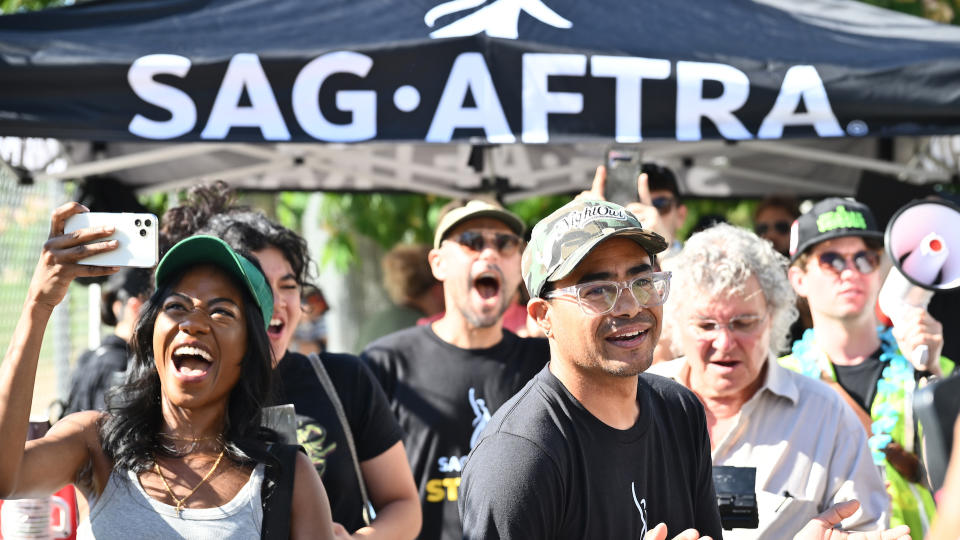SAG-AFTRA Reaches Tentative Deal with Studios to End Actors Strike

SAG-AFTRA has reached a tentative agreement on a new deal with the studios that will bring an end to the actors strike, which has now lasted for 118 days. The strike will end tomorrow, November 9, at 12:01 a.m. PT, the guild announced.
While members of the actors guild will still have to approve it, the tentative deal is expected to meet SAG’s major demands around improved residuals, higher minimum wages, self-taped auditions, and protections for an actor’s likeness against AI. Specific terms of the contract were not immediately disclosed.
More from IndieWire
“In a unanimous vote this afternoon, The SAG-AFTRA TV/Theatrical Committee approved a tentative agreement with the AMPTP bringing an end to the 118 day strike. The strike officially ends at 12:01 a.m. on Thursday, November 9. The tentative deal will go to the SAG-AFTRA National Board on Friday, November 10, 2023, for review and consideration. Further details will be released following that meeting,” the guild said in a statement.
SAG-AFTRA has been striking AMPTP productions since July 14; it was the first actors strike against the Alliance of Motion Picture and Television Producers in decades.
The negotiating committee in a statement said the deal agreed upon is worth $1 billion dollars and will enable members “to build sustainable careers.”
“In a contract valued at over one billion dollars, we have achieved a deal of extraordinary scope that includes “above-pattern” minimum compensation increases, unprecedented provisions for consent and compensation that will protect members from the threat of AI, and for the first time establishes a streaming participation bonus,” the committee said. “Our Pension & Health caps have been substantially raised, which will bring much needed value to our plans. In addition, the deal includes numerous improvements for multiple categories including outsize compensation increases for background performers, and critical contract provisions protecting diverse communities. We have arrived at a contract that will enable SAG-AFTRA members from every category to build sustainable careers. Many thousands of performers now and into the future will benefit from this work.”
“This tentative agreement represents a new paradigm. It gives SAG-AFTRA the biggest contract-on-contract gains in the history of the union, including the largest increase in minimum wages in the last forty years; a brand new residual for streaming programs; extensive consent and compensation protections in the use of artificial intelligence; and sizable contract increases on items across the board,” the AMPTP said in a statement. “The AMPTP is pleased to have reached a tentative agreement and looks forward to the industry resuming the work of telling great stories.”

Writers had beaten the actors to the punch — and to the picket lines. The WGA went on strike against the studios on May 2. After 148 struck days, the writers guild reached a tentative deal of its own with the AMPTP on September 24. On October 9, the agreement was ratified with 99 percent of the writers voting to end the strike.
On Oct. 2, the studios came back to the bargaining table with SAG-AFTRA. Talks broke down on October 11 over a change in the guild’s proposal for a streaming revenue sharing model, which Netflix CEO Ted Sarandos called a “levy” on subscribers and a “bridge too far” for the studios. A group of A-list actors led by George Clooney proposed eliminating the cap on member dues as a way of making up the gap between the studios and guild, but the negotiating committee ultimately rejected that proposal. The two sides returned to the table again on Oct. 24.
A deal seemed imminent early in November, but the guild balked at the studio’s AI proposal, which according to a report in THR included the ability for studios to use scans of deceased performers without the consent of the performer’s estate or SAG-AFTRA. A follow-up report in Variety said the studios adjusted that AI language in a final push to end the strike.
Since mid July, many of SAG-AFTRA’s 160,000+ members have been picketing outside Hollywood’s major studios. As part of the strike rules, actors were forbidden from working on AMPTP-affiliated projects. They could not even promote their work — past, present, or future — made for a studio. The guild even asked members not to dress in Halloween costumes inspired by studio films. Not only were productions largely shut down, so too were the publicity machines around these films, putting a wrench in the fall film festivals, delaying the Emmy Awards, and causing studios to delay their theatrical releases until stars were able to promote.
Exceptions were carved out for independent films that signed an interim agreement. Hundreds of movies applied and agreed to SAG-AFTRA’s original terms as proposed to the AMPTP, meaning that those projects were allowed to resume production with actors, cast their films, and even have actors promote them without guild interference. Major stars returned to work on such indie features or appeared on red carpets at fall festivals, creating a stir among some actors who believed it amounted to scabbing. But the guild repeatedly defended the interim agreements as a vital part of its negotiating strategy, even after SAG-AFTRA amended the agreement’s eligibility requirements to disallow WGA-covered projects while the writers were still on strike.
The actors last went on strike against the studios back in 1980 for three months and three days in a fight over home-video residuals, one that shut down film and TV production and even saw actors boycotting the Emmys. The 2023 edition was the guild’s longest strike against the film and TV studios in its history.
Best of IndieWire
The Best LGBTQ Movies and TV Shows Streaming on Netflix Right Now
Guillermo del Toro's Favorite Movies: 54 Films the Director Wants You to See
Nicolas Winding Refn's Favorite Films: 37 Movies the Director Wants You to See
Sign up for Indiewire's Newsletter. For the latest news, follow us on Facebook, Twitter, and Instagram.
